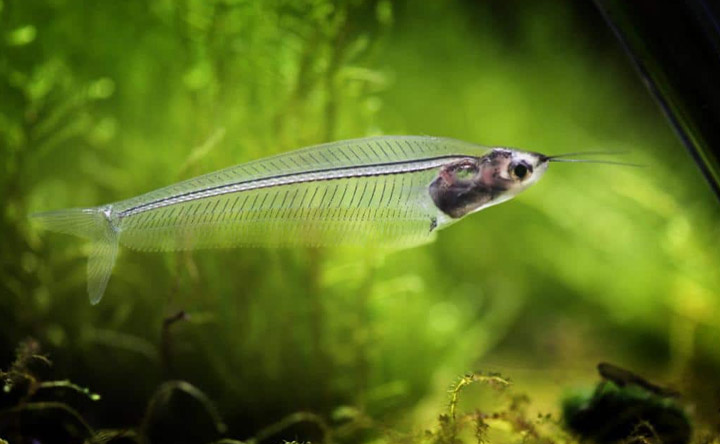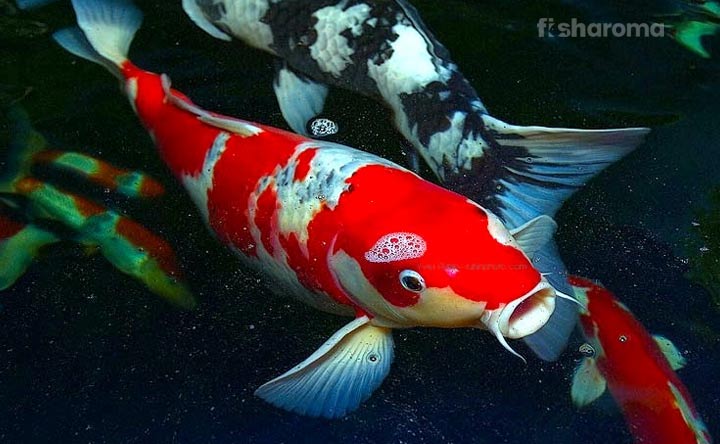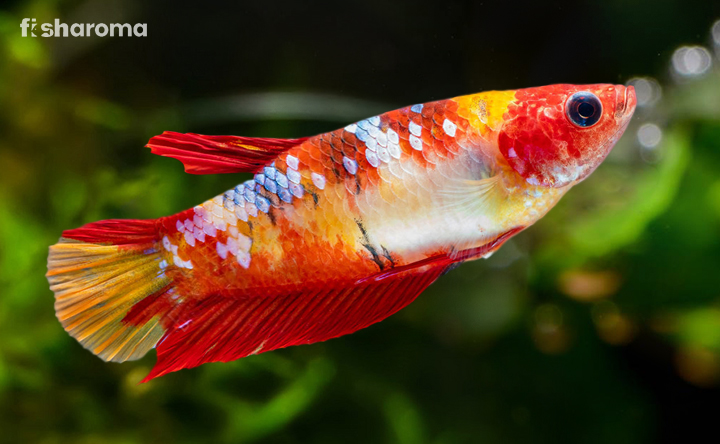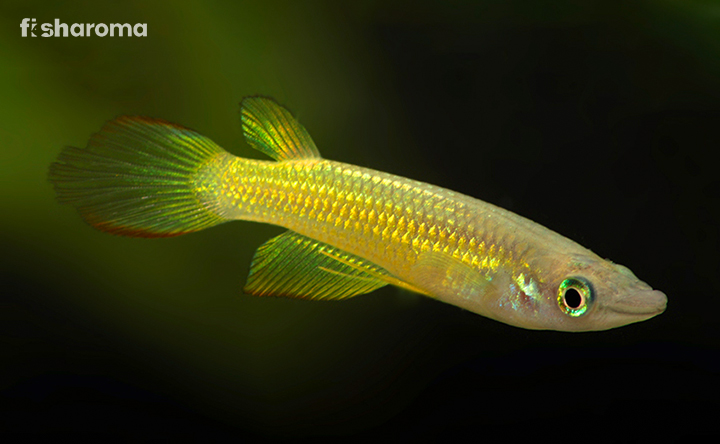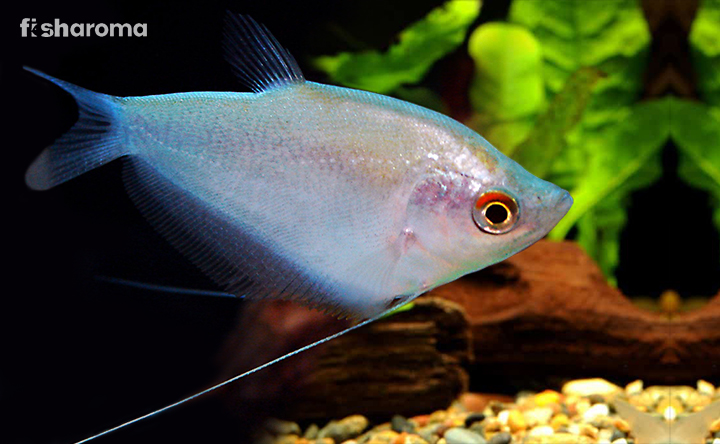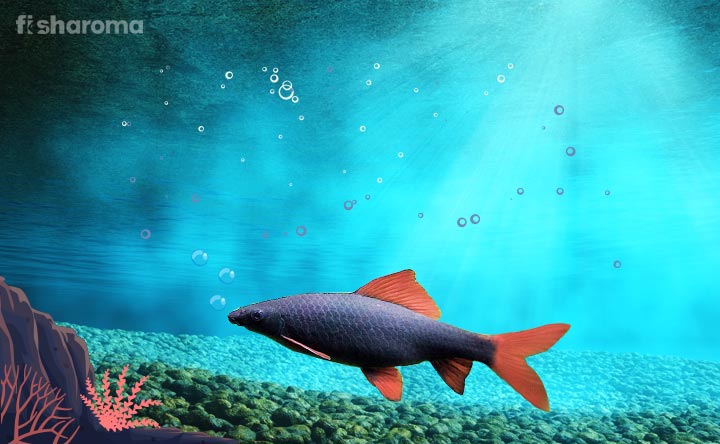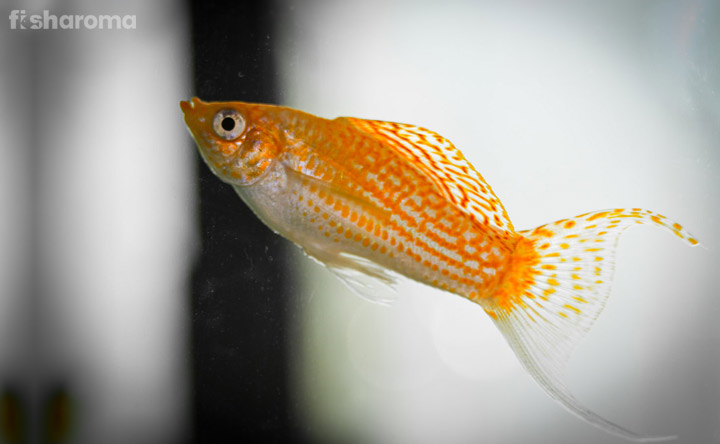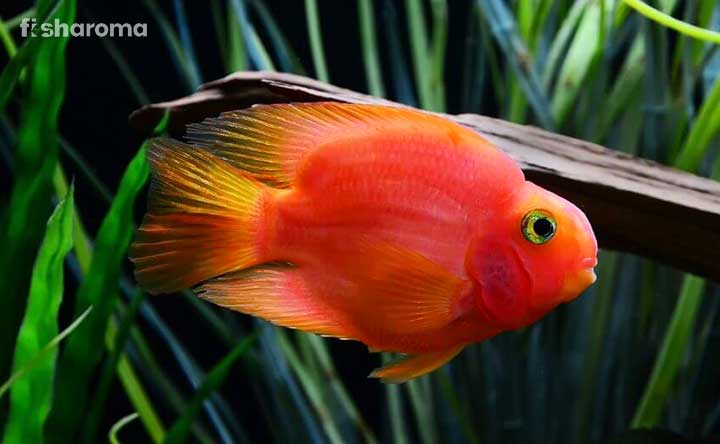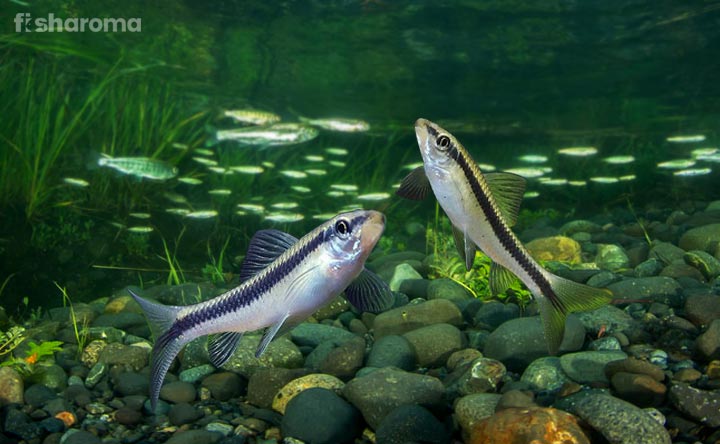Firemouth Cichlid – The Complete Care Guide of This Bluffmaster Fish
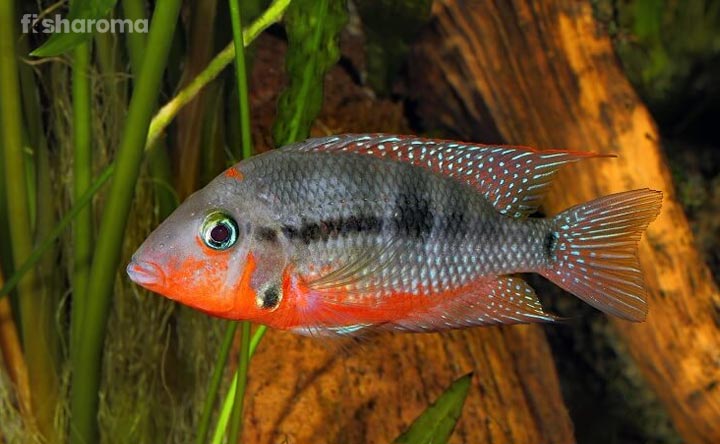
- Origin & Habitat of Firemouth Cichlid
- Appearance of Firemouth Cichlid
- Behaviour of Firemouth Cichlid
- Lifespan of Firemouth Cichlid
- Diet of Firemouth Cichlid
- Tank Requirements for Firemouth Cichlid
- Water Type for Firemouth Cichlid
- Compatibility of Firemouth Cichlid
- Breeding of Firemouth Cichlid
- Firemouth Cichlid Diseases
- Summary
Highly recommended for beginner aquarists, the Firemouth Cichlid is a peaceful freshwater species that will keep you enthralled with its amusing behavior, primary among which is its ability to play “bluffs” to intimidate its own kind. But before accepting the responsibility of raising this fiery-tempered beast, you need to update yourself with the knowledge of its diet, lifespan, tank requirements, breeding procedure, among others. This is where we come into play because we are providing you with their in-depth care guide. So, follow through!
Key Specifications of Firemouth Cichlid
It is extremely important to be aware of the key specifications of your pet before you get to know it in depth. So, here’s presenting some of the most important parameters of Firemouth Cichlid.
| Scientific Name | Thorichthys meeki |
| Family | Cichlidae |
| Origin | Central America |
| Size | 4-5″ (10-12 cm) |
| Color | Grey with a visible red, blue, and black presence |
| Care Level | Easy |
| Lifespan | 15 Years |
| Temperament | Semi-Aggressive |
| Compatibility | High |
| Tank Size | 30 Gallons |
| Diet | Omnivore |
Overview
Firemouth Cichlid was first described by Walter Brind in the year 1918. One of the popular members of the Cichlidae family, its docile nature can quickly turn into an aggressive one when it is threatened.
Previously named Cichlasoma meeki, this territorial fish is now scientifically called Thorichthys meeki. Breaking down the name throws a bit more light into its background.
The first part of its scientific name, which is the genus name – Thorichthys – has been derived from a Greek word which translates to “leaping fish”. The second part, which is the specific name – meeki – has been kept as a tribute to prolific American ichthyologist Seth Eugene Meek, who was the first person to compile a book on Mexican freshwater fish.
Origin & Habitat of Firemouth Cichlids
Native to Central America, Firemouth Cichlids can be found in abundance in the Yucatán Peninsula of Mexico, Honduras, El Salvador, Costa Rica, Panama, Nicaragua, Belize, and Guatemala. However, due to human intervention, they can now be found in Asian Countries such as the Philippines, Singapore, Israel, as well as in the Australian continent. Furthermore, it has also become an invasive species in the USA (Arizona, Hawaii, and Florida) and Puerto Rico.
Speaking of habitat, these freshwater species inhabit the mid to bottom layer of slow-moving rivers, canals, streams, and ponds that have a muddy or sandy substrate. They also prefer living in the shallow water in the vicinity of vegetation since it caters their need for algae and meaty foods.
An interesting aspect about them is that they have been spotted living in water with poor visibility as well as in crystal clear water, which speaks volumes about their adaptability to varied environments. They have been seen inhabiting slightly brackish water as well.
Appearance of Firemouth Cichlids
One of the most prominent features of Firemouth Cichlids is their ‘teardrop’-shaped body. They have a steeply sloping forehead that puts emphasis on their pointed snout. Their laterally compressed bodies are accented by their pointed and broad anal and dorsal fins.
The spiny rays located in the back parts of their dorsal, anal, pelvic and pectoral fins help them in steering predators away. The softness of the frontal part of their fins facilitate effortless movement and in maintaining a precise position in the water instead of fast swimming.
Along with a regular set of teeth, they also have a well-developed pharyngeal set of teeth that are located in their throat. In addition, they have one nostril on both sides which is unlike most other fish that have two sets of nostrils.
Males have longer fin rays while the females have larger bellies which give them a more rounded shape.
Size of Firemouth Cichlid
They are one of the smallest variants of Central American Cichlids. In the wild, they can grow up to 6.5″ (17 cm). However, when kept in captivity, they are slightly smaller, with the males reaching a size of 5″ (12.7 cm) and their female counterparts growing up to about 4″ (10.15 cm).
Color of Firemouth Cichlid
Firemouths have a grey body with tinges of blue-olive coloration. Presence of bright red or orange can be seen on the underside of their heads, specifically where their gills are. This fiery-red color is more prominent in males and is the reason why this fish is named “Firemouth”. The red coloration also extends from their mouth to the base of their tail.
Their fins (except the pectoral ones) also have a reddish-brown edge to them with occasional blue spots. A series of vertical, black bands can be seen all across their bodies, starting from the end of their eyes to the start of their caudal fins.
Behavior of Firemouth Cichlids
Although Firemouths are peaceful, moments of aggression often stem out owing to their territorial nature. This also means that they aren’t a schooling fish. Monogamous by nature, they build strong nuclear families and make for excellent parents.
A rather intriguing aspect about them is their tendency to rearrange and move stones and aquatic plants. They are usually seen spending a lot of time near the substrate wherein they often dig out aquatic plants and move them to a different place in the tank.
The male members are also known as efficient bluffmasters since they often “bluff” by aggressively inflating their fiery red gill covers and throat sacs to impress females and scare off their male competitors.
Lifespan of Firemouth Cichlids
Similar to other members of their family, Firemouth Cichlids also have a long lifespan. So, you have to invest a lot of time if you want to pet them. If kept properly, they can live up to 15 years in captivity, although reports of them living till the age of 20 have also been noted.
Diet of Firemouth Cichlids
Omnivores by nature, you can feed your Firemouths all types of food, ranging from live food to flakes. Having a variety in their diet is essential, which is why they must be fed quality pellets or flake food every day.
Feeding them twice daily in small quantities is the key. You will also frequently notice them sifting through a mouthful of sand. This denotes their scavenging nature which makes them look for leftover food at the bottom of the tank. They are also known to feed on algae.
A proper diet of Firemouth Cichlid should consist of the following items:
- Copepod
- Organic Detritus
- Water Flea
- Brine Shrimp
- Daphnia
- Bloodworm
- Tubifex
- Cyclops
- White Worm
- Mosquito Larvae
- Blanched Spinach
- Blanched Cucumber
- Spirulina
- Mollusc
Coming to artificial food, you can go for Hikari Cichlid Gold Floating Pellets for Pets since they are made of the highest quality ingredients.
A high intake of protein would severely affect the digestive system of Firemouth Cichlid. Thus, try to maintain a balance.
Tank Requirements for Firemouth Cichlids
It is very important to create a safe home-like environment for your pet to help them grow as naturally as possible. To facilitate that, you need to keep in mind the following points in mind.
Tank Size
For a single Firemouth Cichlid, a 15-gallon tank would suffice. However, since it is advised to keep them in a pair, you would require a 30-gallon tank. Remember, they are highly territorial and would always prefer a larger thank where they don’t feel claustrophobic.
Tank Lid
The first part of their scientific name literally translates to “leaping fish”. So, it goes without saying how crucial a firm tank lid is for their safety. We advise you to keep a gap of at least 10” (25 cm) between the water surface and the tank lid otherwise, your Firemouth can hit the ceiling, injuring itself.
Substrate
Since Firemouth Cichlids love spending a majority of its time digging through the substrate, you need to make sure that are no sharp-edged or toxic-colored substrate is used in their tank. Therefore, providing them natural fine-grained sand is the best option.
Filter
They are highly intolerant towards nitrite, nitrate, and ammonia. Thus, to keep a check on the level of these nitrogen compounds and for proper aeration, you need to provide them a good filtration system. The filter that you choose must also be able to create movement in the tank water similar to its natural environment, which is, slow-moving water.
Nature of Lighting
Firemouths are not very fussy about the choice of lights that you keep. Moderate lighting should be used for them. Their natural habitat is mostly dark due to the heavy vegetation, but they can also survive in a moderate light setting.
Presence of Flora
As we have stated above, the habitat of Firemouths is filled with dense vegetation. So, it goes without saying that adding aquatic plants in your tank is definitely a good idea. However, due to their tendency of uprooting plants, you need to ensure that the plants are potted. A hardy plant such as Sagittaria (Arrowhead) seems ideal for them.
Regarding the placement of the plant, you need to keep it inside the perimeter while leaving an open area in the center for swimming. Large-leaved plants are also recommended since they will provide the much-needed shade to them.
Ornaments
Since this tropical species loves hiding, you can always include caves, sunken wood, and rocks in their tank. Including leaf litter and small branches of trees is also an excellent idea here.
Firemouths rearrange the aquarium by moving rocks and gravels from one place to another. Thus, it is advised to stick them to the surface using water safe silicone glue. However, use the glue only when you are sure that you yourself aren’t someone who frequently rearranges aquarium substrate.
Cleaning Method
Cleaning your tank helps increase the longevity of your pet. It is always a good idea to maintain regularity in your cleaning process. The golden rule of thumb that you need to follow here is that never to use any soap-based product for cleaning purposes since their residue is harmful to the health of your fish.
Simply use lukewarm water and a soft cloth to clean the interior walls of your tank and put the ornaments and substrate under running water for cleaning them. Else, you may also use a gravel cleaner to get rid of the decomposing organic matter that has built up over time in your tank. While getting rid of algae, try to keep a thin layer of them in your tank since it acts as an additional food source for your Cichlid.
Water Type for Firemouth Cichlids
Since it is a freshwater species, you can use your tap water to fill up their tank. However, it should meet the following parameters.
Temperature
The temperature of the water should be 75 – 78.8° F (24 – 26° C). Install a submerged thermometer to keep a daily tab on the temperature.
pH Level
The pH level of the tank water should be 6.5-8. Although they aren’t very fussy about it, it never harms to keep a track of the pH through pH testing kits available in the market.
Hardness
Similar to the pH level, Firemouth Cichlids are also not very fussy about the hardness of the water. Still, try to keep the general hardness of the water between 8-15 dGH.
Mineral Level
Firemouths are sensitive to the level of nitrogen in their vicinity. Therefore, pay extra attention to this sector. Keep the level of nitrite and ammonia zero and the amount of nitrate less than 20 mg/l.
Replacement Procedure
As time passes by, the level of phosphates and nitrate increases in your tank. The hardness of the water also rises due to evaporation. Therefore, regular replacement of the tank water is crucial.
Never replace the entire water content of your tank since it will kill off the beneficial bacteria which are essential for cycling your tank. In addition, the new batch of water that you add in the tank should have the same parameters as that of the existing batch of water.
You can choose any of the three following water replacement procedures. Don’t follow all three. PICK ONLY ONE!
| Percentage of Tank Water to Be Replaced | Frequency of Water Replacement |
| 10% | Weekly |
| 20% | Fortnightly |
| 40% | Monthly |
Compatibility of Firemouth Cichlids
Firemouth Cichlids can be kept in a group if enough space is provided to them. However, remember that they are not schooling fish. So, don’t expect them to swim together in tune in your tank. In the wild, males usually live separately in their own territory while the females and juveniles stick together.
Suitable Tankmates for Firemouth Cichlid
Speaking of community tanks, they can survive in it if it has hiding spots and is filled with non-aggressive and similar-sized fish. Firemouths are essentially peaceful apart from when they spawn.
An interesting aspect regarding their compatibility is that the males tend to suffer more in comparison to the females when it comes to harassment from aggressive or larger tankmates. The females have a way of finding protection under the wings (fins, no pun intended) of other species.
Ideal tankmates for a Firemouth Cichlid are as follows:
- Similarly-sized South American Cichlid
- Rummy Nose Tetra
- Serpae Tetra
- Glowlight Tetra
- Pictus Catfish
Unsuitable Tankmates for Firemouth Cichlid
When it comes to the species that you need to avoid keeping with a Firemouth Cichlid, there are a few things that you need to bear in mind. First of all, avoid keeping them with larger and aggressive species. Secondly, avoid slow-moving fish since they will get bullied by Firemouth; and thirdly, don’t put small invertebrate in their tank since they will be mistaken for their food.
Keeping these factors in mind, some of the unsuitable tankmates for a Firemouth Cichlid are as follows:
- Dwarf Cichlid
- Angelfish
- Snail
- Shrimp
Breeding of Firemouth Cichlids
Firemouth Cichlids are monogamous beings that usually pair up by themselves, which is why it is better to keep around six Firemouths together.
They are also very non-demanding about the water parameters that they need. However, to facilitate the process set the pH level to 7, the general hardness at 10 dGH, and the temperature between 75-79° F (23-26° C). A Quality diet also encourages spawning. To be honest, they breed without the encouragement of aquarists.
Females usually lay 100-500 eggs at a time on solid flat surfaces such as large leaves, flat rock, wood, or even the glass surface of the tank after cleaning them by themselves. While both the parents take care of the eggs, it is the female who swings its pectoral fins in the fashion of a fan over the eggs to enable the inflow of new water to get high oxygen. The female lays the eggs in a long row and the males move along the same row to fertilize them.
Males become extremely protective over the eggs during the stage and display aggressive behavior towards other species in the tank. So, maybe keeping the Firemouths in a separate tank is not a bad idea during breeding.
The incubation period in them is 3-6 days and 4-5 days after that, the fires start swimming on their own. You can feed them baby Brine Shrimp at this stage. For the first six weeks, the parents escort their babies to different areas of the tank to make sure they find proper food, after which they part their ways. If possible, separate the larger fries from the smaller ones to avoid cannibalism in them.
They make for excellent parents and prefer forming strong nuclear families.
If your Firemouths are breeding for the first time, then they might eat their own eggs; but they soon learn and stop this behavior the next time they breed.
Firemouth Cichlids Diseases
Just like most other freshwater species, Firemouth Cichlids are also not immune to Ich (Ichthyophthirius), which is marked by white spots on all over their bodies and fins. Thankfully, since they can tolerate high temperatures, you can cure Ich by slightly increasing the temperature of the tank to a few degrees 86° F (30° C) for a couple of days.
Besides, they also suffer from the following:
- Parasitic infestations such as worms, protozoa, among others.
- Bacterial infections
- Fungal infections.
Consult a veterinarian in these circumstances to seek a proper and safe remedy.
It is always better to use precaution than care. Therefore, quarantine any foreign material beforehand that you want to put in the tank (ornaments, substrate, and even the fish itself). Regularly clean your tank and provide quality food to them to ensure their proper health.
Interesting Facts about Firemouth Cichlid
- Firemouth Cichlids are also known as Red Breasted Cichlids.
- They have a funny way of “smelling” water, which they do so by sucking water and expelling it back out after “sampling” It for a short period of time.
- The colors of this freshwater species are also determined by the habitat they live in.
- Sometimes, they breed 5-6 times a year.
Summary
Firemouth Cichlids are extremely easy to care for and is ideal for those who don’t have a lot of experience in fishkeeping. This is due to the fact that they are highly adaptable to varied water parameters and tank conditions. Breeding them is extremely hassle-free, to the point that you don’t even have to bother about encouraging it.
The only aspect where they might give you a bit of trouble is while selecting their tankmates because Firemouth can be quite fussy about its personal space, especially the male ones.
A Look at Our Other Cichlid-Based Articles
If you are a fan of Cichlids in general, then these following articles might interest you.
- How to Set Up a Cichlid Tank? – The first order of business before you bring home Cichlids is to create a safe home for them. Learn how to do it from here.
- Convict Cichlid Care Guide – This black-and-white beauty is known or its active and aggressive behavior. Learn how you can pet them from here.
- African Cichlid Care Guide – Enter the world of African Cichlids to find out the diversity that exists in their community.

